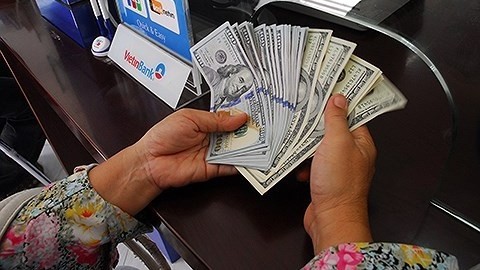The USD price index in October went down by 0.07% compared to the end of 2016 and the average index in the first ten months of this year rose by only 1.67%, over the same period last year.
The foreign currency market has not witnessed any significant fluctuations, even in the short term, and the actual exchange rate is not much different from the central rate announced by the State Bank of Vietnam (SBV). Meanwhile, the central exchange rate was adjusted flexibly according to market signals, which demonstrated that the effective intervention of the SBV in the balance of supply and demand for foreign currencies on the market has diminished the holding of foreign currencies and dollarisation.
The exchange rate policy has been supported by an interest rate policy for the US dollar and the policy for foreign currency lending of the SBV, in the context of continuously increased trade surplus and foreign investment flow into Vietnam. Therefore, the SBV has bought a large amount of foreign currency, creating the largest ever foreign currency reserve (US$46 billion), while ensuring the liquidity of the foreign currency market.
Thanks to the SBV’s flexible exchange rate policy, which is in line with supply and demand for foreign currencies on the domestic market, as well as the developments in the international market, the foreign currency market has remained since the beginning of 2017. Currently, the SBV not only has a system of effective mechanisms and policies but has also strengthened its financial capacity, ensuring that it is capable of intervening in the market when necessary. In addition, a series of positive macroeconomic news, such as trade surplus of US$1.23 billion in the first ten months, FDI reaching US$14.2 billion in the same period, and billions of US dollars of foreign capital being poured into the stock market, are an indispensable result of the activities to reduce the speculation and holding of foreign currencies, as well as increasing the confidence in the value of Vietnamese dong.
With the abundant and stable foreign currency supply, the demand for legal and reasonable foreign currency has been met on the basis of ensuring the balance of the supply and demand in the official foreign exchange market. Accordingly, the unofficial foreign exchange market has continued to be narrowed, while its influence on the fluctuation of the foreign exchange rate has been reduced. The psychological development in the domestic market has been more stable despite a number of fluctuations in the international market.
The above positive factors have been and will contribute to reducing the pressure of weakening the Vietnamese dong against the US dollar. In addition, the central exchange rate is calculated based on a basket of currencies instead of anchoring the US dollar as before. Therefore, the fluctuations of the US dollar have been adjusted in correlation with the key currencies, as well as with the key trading and financial partners of Vietnam.
The supply for foreign currency is forecast to continue to be supported by the flows of foreign direct and indirect investment into Vietnam, along with trade surplus, in the last months of this year. The increased demand for foreign currency to serve production and business, as well as consumption and the daily life of the people, will continue to be ensured in a stable manner. In addition, if the US Federal Reserve increases its interest rates, the SBV will have measures prepared to adapt to and maintain the stability of the foreign exchange market in general and the exchange rate in particular. The current flexible mechanism for the central exchange rates is an effective tool in order to minimise the negative impact from the world financial markets.
















